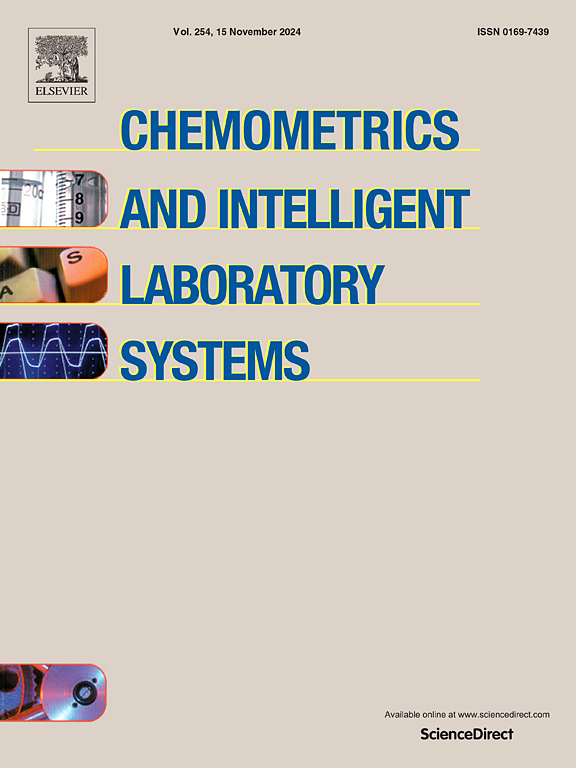Significance determination of individual metabolic abundance changes owing to environmental impacts: Factorial design t-distribution spectral representations
IF 3.8
2区 化学
Q2 AUTOMATION & CONTROL SYSTEMS
Chemometrics and Intelligent Laboratory Systems
Pub Date : 2025-04-26
DOI:10.1016/j.chemolab.2025.105413
引用次数: 0
Abstract
Currently quantitative metabolic analysis is work-intensive and time-consuming normally demanding the use of both chromatography and mass spectrometry. Screening spectral data with principal component analysis is fast and helps identify metabolites. However, it has not been used for quantitative analysis as it cannot determine the statistical significance of individual metabolite abundance changes owing to simulated environmental impacts. Factorial design t univariate spectral representations provide a relatively fast and simple method to determine the statistical significance of individual NMR channels forming peaks and help fill the gap between qualitative and quantitative metabolic analysis of plants suffering environmental impacts. These composite spectral representations, introduced and described for the first time, are univariate statistical t values calculated from factorial design spectra plotted as a function of the analytical channels. They are simple to understand by chemists and biologists with limited statistical knowledge as they only use one basic statistical t distribution equation. We demonstrate their usefulness with factorial design analyses of 1H NMR spectra of yerba mate samples obtained from different solvent extracts of a mixture design. The spectral representation peak locations are almost the same as those of principal component loadings of ASCA effect matrices although their peak heights are much different and correspond to the statistical significance levels of individual metabolic abundance changes. Spectral representations have ordinates of calculated t values and results for different data sets can be analyzed simultaneously on a common graph whereas this is not possible for loadings that correspond to different PCA coordinate spaces.
环境影响下个体代谢丰度变化的显著性测定:析因设计t分布谱表示
目前,定量代谢分析工作量大,耗时长,通常需要使用色谱法和质谱法。筛选光谱数据与主成分分析是快速的,并有助于识别代谢物。然而,由于它无法确定由于模拟环境影响而导致的个体代谢物丰度变化的统计显著性,因此尚未用于定量分析。析因设计-单变量光谱表征提供了一种相对快速和简单的方法来确定单个核磁共振通道形成峰的统计显著性,有助于填补受环境影响植物的定性和定量代谢分析之间的空白。首次介绍和描述的这些复合光谱表示是单变量统计t值,由析因设计光谱作为分析通道的函数计算得出。对于统计知识有限的化学家和生物学家来说,它们很容易理解,因为它们只使用一个基本的统计分布方程。我们用析因设计分析了从混合设计的不同溶剂提取物中获得的马茶样品的1H NMR谱,证明了它们的实用性。光谱表征峰的位置与ASCA效应矩阵的主成分负荷几乎相同,尽管它们的峰高差异很大,并对应于个体代谢丰度变化的统计显著水平。谱表示具有计算的t值的坐标,不同数据集的结果可以在一个共同的图上同时分析,而这对于对应于不同PCA坐标空间的加载是不可能的。
本文章由计算机程序翻译,如有差异,请以英文原文为准。
求助全文
约1分钟内获得全文
求助全文
来源期刊
CiteScore
7.50
自引率
7.70%
发文量
169
审稿时长
3.4 months
期刊介绍:
Chemometrics and Intelligent Laboratory Systems publishes original research papers, short communications, reviews, tutorials and Original Software Publications reporting on development of novel statistical, mathematical, or computer techniques in Chemistry and related disciplines.
Chemometrics is the chemical discipline that uses mathematical and statistical methods to design or select optimal procedures and experiments, and to provide maximum chemical information by analysing chemical data.
The journal deals with the following topics:
1) Development of new statistical, mathematical and chemometrical methods for Chemistry and related fields (Environmental Chemistry, Biochemistry, Toxicology, System Biology, -Omics, etc.)
2) Novel applications of chemometrics to all branches of Chemistry and related fields (typical domains of interest are: process data analysis, experimental design, data mining, signal processing, supervised modelling, decision making, robust statistics, mixture analysis, multivariate calibration etc.) Routine applications of established chemometrical techniques will not be considered.
3) Development of new software that provides novel tools or truly advances the use of chemometrical methods.
4) Well characterized data sets to test performance for the new methods and software.
The journal complies with International Committee of Medical Journal Editors'' Uniform requirements for manuscripts.

 求助内容:
求助内容: 应助结果提醒方式:
应助结果提醒方式:


